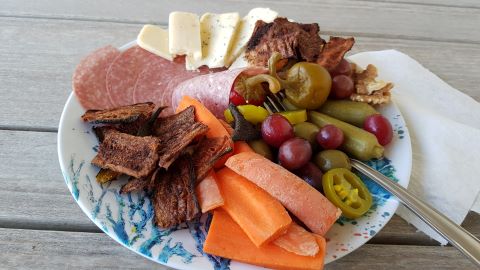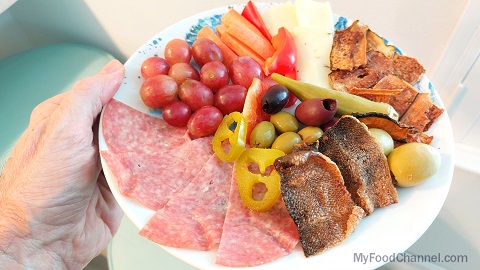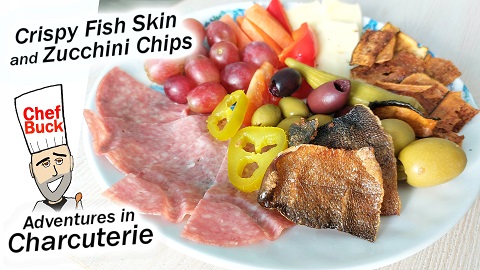Need charcuterie ideas? The most important aspect of a charcuterie board – include foods that YOU want to eat, perhaps trying one or two new things! The options are endless. Sometimes, Chef Buck and I think we want a charcuterie plate but end up just getting out some veggies and hummus, or just some nuts, or just some cheese. Since we often make meals for just the two of us, a charcuterie collection is our starting point but we let our mood ultimately guide us.
Chef Buck and I have been on the search for the perfect non-gluten snacks to go with a glass of wine. And well, we are generally eaters rather than mere nibblers, so we often are looking for more than a small block of good chocolate or a bowl of peanuts. A charcuterie plate/board/platter, aka a varied plate of cold cuts and other yummy morsels, is just the ticket!
Strictly speaking, charcuterie (shar-KOO-ta-REE) is a shop where you can buy cold meats and meat dishes, and the term can also refer to the meat products sold in such a shop. But you can go to a shop, restaurant or someone’s home and a referenced charcuterie board or platter can contain much more than cold cuts. In this blog, we explore some of our favorite charcuterie ideas, and a couple of experimental ingredients.
Charcuterie Ideas – Have A Variety of Textures and Tastes
COLD MEATS. Since charcuterie specifically references cold meats, let’s start there. Yes, you can use cold cuts from your grocery deli, sliced extra thin. We enjoy something with a bit of flavor, so we lean toward varieties of salami. Have you tried any summer sausages? Summer sausages is a general term for fully cooked sausages that do not require refrigeration until after the packaging is opened; they are especially plentiful around the holiday times. We have tried a couple of the cured meats with no preservatives. However, we found them a bit too dry and chewy, perhaps because we’ve spent decades eating other varieties. You can check prices for fancy charcuterie meats on Amazon.

PICKLED OR BRINED ITEMS. Chef Buck’s charcuterie plate is never complete without some olives. He prefers pitted kalamata (black, actually deep purple) olives as well as plump green manzanilla olives stuffed with pimentos or jalapenos. If you feel like really splurging, try some castelvetrano olives. They are also green but have a buttery goodness that are a special treat. Beyond olives, perhaps you’ll want to include a bite of marinated artichokes, pickled cherry peppers, pickled okra or just some plain pickles.
CHEESES. A creamy cheese is one of my favorite additions to our charcuterie plates. We’re always happy with a smoked gouda or creamy havarti. We’ve had successful experiments with creamy cheeses we can easily find in our local grocery store: dill havarti, caramelized onion gouda. But you don’t have to stop with just the creamy cheeses. We’ve added a herbed goat cheese, that had such a gusto of flavor that we didn’t need as much variety on that night’s plate – some veggies and nuts worked. We’ve had some harder cheeses when we’ve picked a white wine that has a particularly strong flavor.
FRESH VEGETABLES and FRUITS. We add fresh veggies and fruits to our charcuterie for some crunch and as the ocassional palate cleanser. And hey, Chef Buck thinks this addition makes the whole plate healthy. Some of our favorite fresh vegetables for a charcuterie plate are red/purple/yellow bell pepper, carrots, radishes, cauliflower florets. We once found a purple daikon at a local farmer’s market – it was a great addition with a burst of color. Grapes are an easy addition to a charcuterie. Perhaps you want some sweeter figs or berries? Or maybe cut up some apples or other seasonal fruit (peaches, pears) and sprinkle them with some lemon juice to slow down the browning process.
DRIED FRUITS. When the wine and fresh fruits are enough to satisfy your sweet tooth, and perhaps your seasonal fruit options are slim, consider adding a couple pieces of dried fruit. Dried apricots, cranberries, even prunes can provide some contrast to your briny/pickled options. Want some fancier options? Add dried figs, mango and/or pineapple.
BREAD, CRACKERS. Bread, breadsticks, crackers – all go well with meats, cheeses and many of your other charcuterie choices. They are a favorite for many people on their charcuterie boards. In college, my roommate and I survived the two weeks before leaving for the holidays, by living on the Hickory Farms gift packages of cocktail bread (fancy, miniature loaves of plain, wheat, rye or pumpernickel), sausage and cheeses, coupled with ridiculously big slathers of mayo.
SPREADS. You can include sweet and savory options. Jars of preserves, jellies or chutney provide a different taste combo with a bite of meat, cheese, bread or cracker. Jalopeno jelly is one of our favorite jellies. Although we think they are especially messy, honey or syrups also provide different flavor and texture profiles. And for savory options, add some mustard, maybe even some horseradish or wasabi. You can add olives in the form of a tapenade. And yes, you can include some of your favorite dip – it’s YOUR charcuterie after all!
OTHER NON-GLUTEN OPTIONS. Since Chef Buck and I have been eating less bread and crackers, we’ve been exploring some additional non-gluten options for our charcuteries. Nuts are one of our favorite and again, the options are endless – raw, roasted, candied, spicy. Especially when we’re including a red wine, we sneak in a little dark chocolate. We have added pork rinds but found that their dryness just made us eat more of everything else. The same with the yummy ‘all-cheese’ crackers that have appeared in the last few years, usually made of parmesan and/or other hard cheeses.
How expensive can a charcuterie sampling be? Just for an idea of how pricey something like this can be, here’s a link to a fancy charcuterie board on Amazon. I’m not recommending that you buy a charcuterie assortment online or in a restaurant. You can make something like this at home just as fancy for ⅕ the cost.

Don’t Be Afraid to Experiment with Your Charcuterie Ideas
In the video, you can see two of our charcuterie experiments: one quicker (fried fish skins) and one that takes 2+ hours to slowly bake (zucchini chips). As we mention, we’ve been especially interested in non-gluten options.
FRIED FISH SKINS. We buy smoked trout when we want to have a fancy-pants breakfast. It often comes with a skin on one side. Since we enjoy crisping the skin on salmon or trout fillets, Chef Buck was inspired to try crisping just the skin from our smoked trout. As the video shows, it was messy but a big success. Also, it was a great addition to that night’s charcuterie plates.
ZUCCHINI CHIPS. It wasn’t a typo. It took 2.5 hours to cook a single rack of zucchini chips, from two medium-sized zucchini. Perhaps we need to try dehydrating some? Anyway, although the cooking time is long, the video shows that the process is an easy one. You just cut, oil and season the chips. Place them in a single layer in a pan and cook them in an oven preheated to 250.
Additional Tips for the Perfect Charcuterie Plate
Take your cheese out 20-30 minutes before you’re going to eat it. You’ve spent the money on some fancy cheese – let the flavors and creaminess come through.
Your charcuterie collection can be unrefrigerated for two hours. You were often spared the bother of cooking anything for your charcuterie plate, but it still needs some respect.
Individual charcuterie plates can make a romantic dinner for two. [Plus, individual plates may give you the opportunity to appear generous by ‘sharing’ some of your portion once you’re full, instead of realizing you’ve only eaten two bites from a single charcuterie plate, while your partner gobbled up everything else on the plate.]
You’ve done the hard work by picking your favorite charcuterie ideas. Now, spend a minute on presentation. Make your plate look inviting. Add some color – everything doesn’t have to be red and yellow. It doesn’t have to be much extra effort. Instead of your meat and cheese being in a single stack – fan them out just a smidge. Distribute your colors around a bit. And if you want to ‘go all out’, the internet is full of charcuterie presentation pictures (and instructions) to provide inspiration.
Check out some of our other appetizer recipes!
Thanks for Watching our Videos!
Thanks for checking out our blog regarding charcuterie ideas. Sign up for our mailing list so you’ll never miss a new recipe. Also click a button below and share the dishes with your friends. You can also follow Chef Buck on Youtube. We appreciate all the kind comments and support, and we’ll see you next time in the kitchen!
If you like what CG and I do, support us on Patreon, or throw us a tip in our Paypal Tip Jar. We’ll happily enjoy a coffee on the road – Thanks! We appreciate all the support, and we’ll see you next time in the kitchen!
We include affiliate links for products on our website. Making a purchase after clicking on our links and we may earn a commission which helps us produce more videos and drink more coffee :^) We participate in the Amazon Services LLC Associates Program, which is an affiliate advertising program. It provides a means for us to earn fees by linking to Amazon.com and affiliated sites, so we can make more videos.
